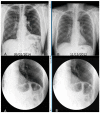Diaphragmatic Palsy
- PMID: 29438332
- PMCID: PMC5871962
- DOI: 10.3390/diseases6010016
Diaphragmatic Palsy
Abstract
The diaphragm is the primary muscle of respiration, and its weakness can lead to respiratory failure. Diaphragmatic palsy can be caused by various causes. Injury to the phrenic nerve during thoracic surgeries is the most common cause for diaphragmatic palsy. Depending on the cause, the symptoms of diaphragmatic palsies vary from completely asymptomatic to disabling dyspnea requiring mechanical ventilation. On pulmonary function tests, there will be a decrease in the maximum respiratory muscle power. Spirometry shows reduced lung functions and a significant drop of lung function in supine position is typical of diaphragmatic palsy. Diaphragmatic movements with respiration can be directly visualized by fluoroscopic examination. Currently, this test is being replaced by bedside thoracic ultrasound examination, looking at the diaphragmic excursion with deep breathing or sniffing. This test is found to be equally efficient, and without risks of ionizing radiation of fluoroscope. Treatment of diaphragmatic palsy depends on the cause. Surgical approach of repair of diaphragm or nonsurgical approach of noninvasive ventilation has been tried with good success. Overall prognosis of diaphragmatic palsy is good, except when it is related to neuromuscular degeneration conditions.
Keywords: diaphragmatic palsy; phrenic nerve injury; pulmonary function tests; respiratory failure.
Conflict of interest statement
The authors declare no conflict of interest.
Figures





References
Publication types
LinkOut - more resources
Full Text Sources
Other Literature Sources

